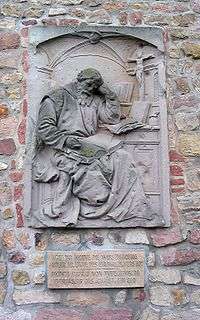Otfrid of Weissenburg

Otfrid of Weissenburg (German: Otfrid von Weißenburg) (c. 800 - after 870) was a monk at the abbey of Weissenburg (modern-day Wissembourg in Alsace) and the author of a gospel harmony in rhyming couplets now called the Evangelienbuch. It is written in the South Rhine Franconian dialect of Old High German. The poem is thought to have been completed between 863 and 871. Otfrid is the first German poet whose name we know from his work. He studied under Hrabanus Maurus at Fulda and had moved to Weissenburg by 830. Apart from the Evangelienbuch, he is the author of a number of works in Latin, including biblical commentary and glossaries.
With 7104 couplets, the Evangelienbuch is the first substantial literary work and the first use of rhyme in German literature - surviving earlier German poetry is alliterative. It is not certain whether Otfrid's choice of form was inspired by Latin models or by vernacular verse which has not survived - Otfrid himself mentions laicorum cantus obscenus ("obscene song of the laiety"), of which there are no survivals.
Otfrid was fully aware of the novelty of his undertaking: the work starts with a section headed 'Cur scriptor hunc librum theotisce dictaverit' ('Why the author has written this book in the vernacular') explaining the reasons for writing in his native dialect rather than in the Latin one would expect for a religious work.
There are three dedications:
- To Louis the German
- To Solomon I, Bishop of Constance (839–871)
- At the end of the work, to his friends Hartmuat and Werinbert, monks at the Abbey of St. Gall
The dedication to Louis is followed by a letter in Latin prose to Luitbert, Archbishop of Mainz, in which Otfried explains the purpose of the work and discusses some of the problems, both orthgraphic and grammatical, of writing in German. He also gives the following outline of the structure of the Evangelienbuch:
I have, then, divided this book into five books. Of them the first commemorates the birth of Christ; it ends with the baptism and the teaching of John. The second, His disciples already having been called together, tells how He revealed Himself to the world both by certain signs and by His most brilliant teaching. The third tells a little about the brilliance of the signs and the teaching to the Jews. The fourth tells then how, approaching His passion, He willingly suffered death for us. The fifth calls to memory His resurrection, His conversation afterwards with His disciples, His ascension and the Day of Judgment. (Translation by James Marchand)
The poem is preserved in four manuscripts, one of which is fragmentary. All the manuscripts are contemporary, and the Vienna manuscript (V) carries corrections which are generally considered to have been made by Otfrid himself. The Heidelberg manuscript (P) also includes the Georgslied.
External links
- Otfrid von Weißenburgʼs Gospel Book - full text of Wolff's 1973 edition.
- Otfrid's letter to Luitbert of Mainz - original Latin text with English translation and commentary by James Marchand
- Otfrid's letter to Luitbert of Mainz - original Latin and parallel English translation
- Images of the Heidelberg manuscript
 Herbermann, Charles, ed. (1913). "Otfried of Weissenburg". Catholic Encyclopedia. New York: Robert Appleton Company.
Herbermann, Charles, ed. (1913). "Otfried of Weissenburg". Catholic Encyclopedia. New York: Robert Appleton Company.
Editions
- Otfrid von Weißenburg, Evangelienbuch Band I: Edition nach dem Wiener Codex 2687, Niemeyer 2004. (Edition of manuscript V) ISBN 3-484-64051-0.
- Otfrids Evangelienbuch, 6th edn, ed. Ludwig Wolff, Tübingen: Niemeyer, 1973. (Altdeutsche Textbibliothek 49.)
- Otfrid von Weißenburg, Evangelienbuch. Auswahl. Althochdeutsch/Neuhochdeutsch, Reclam 1987. (Selections with modern German translation) ISBN 3-15-008384-2.
Sources
- J. Knight Bostock, A Handbook on Old High German Literature, 2nd edn, revised by K.C.King and D.R.McLintock, Oxford 1976.
- W. Schröder "Otfrid von Weißenburg" in Die deutsche Literatur des Mittelalters. Verfasserlexikon (de Gruyter, 1989), Vol. 7.